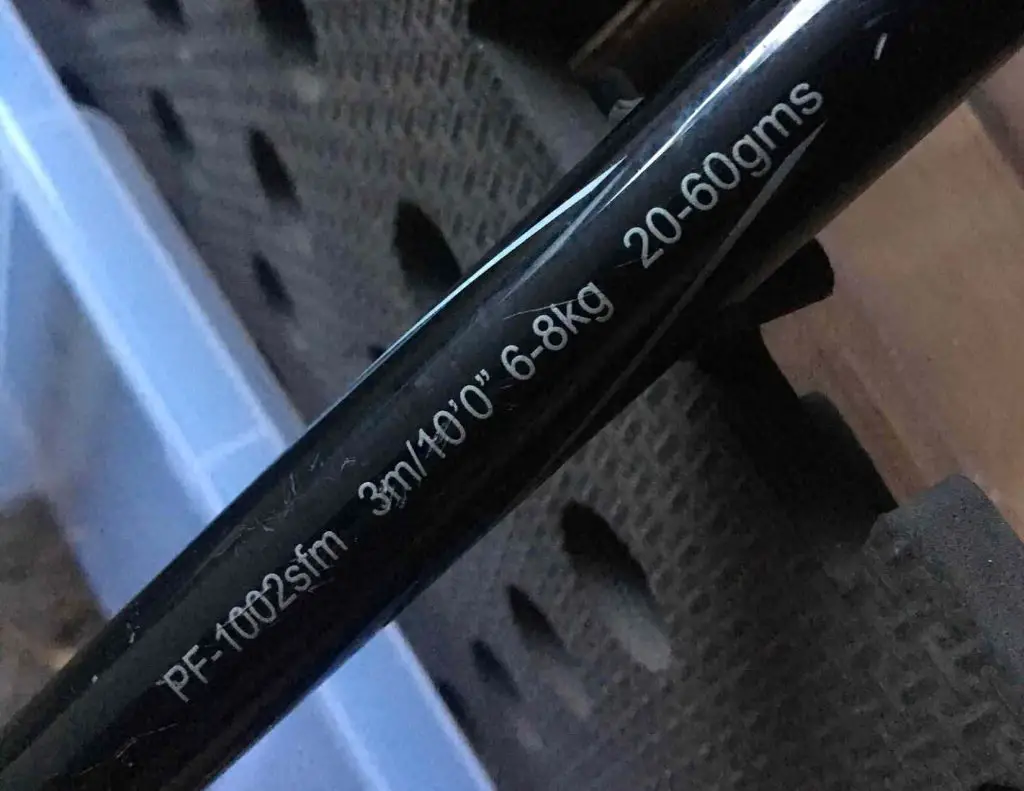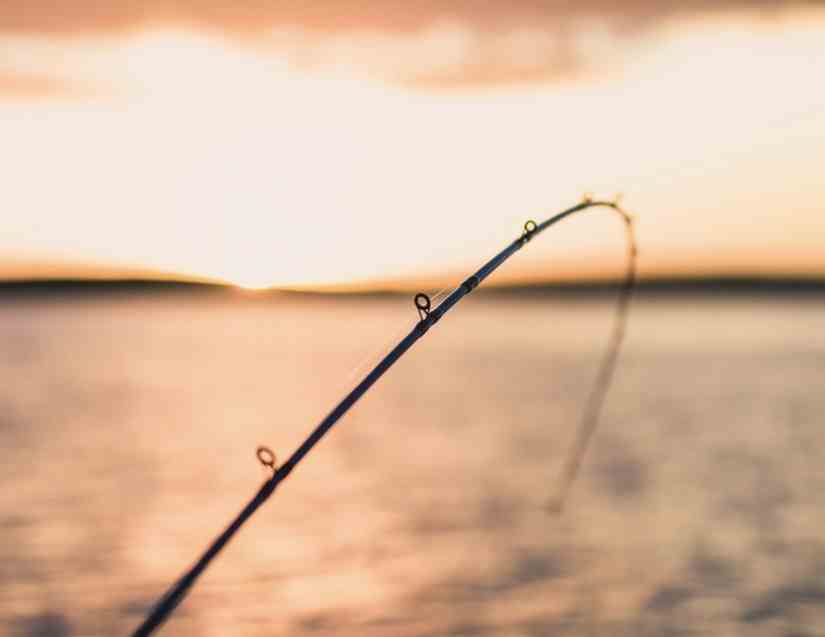When picking a new fishing rod, there are quite a few factors to consider. One of those is the power rating of a rod.
This article compares medium vs medium-heavy rods in particular across multiple factors because these power ratings are a popular choice and often cover a large range of fishing uses.
You should only compare medium vs medium-heavy rods within the same rod manufacturer. There is no consistent standard across the market. Medium rods are good for lighter lures in water with fewer weeds and grass. Medium-heavy rods are better for fishing in water with more cover, to easily pull larger lures through weeds and debris.
Thinking about going lighter? Read our article on what medium-light rods are good for.
If you need help choosing a beginner fishing rod, you may find this guide helpful.
- What does rod weight or power rating mean?
- What is Rod Action?
- What’s the difference between medium and medium-heavy rod power?
- Medium vs medium-heavy rods: use the right lures
- Do medium or medium-heavy rods cast further?
- Medium or medium-heavy rod lure retrieval
- How well do medium vs medium-heavy rods set hooks?
- A Medium or Medium-heavy rod for bass?
- A Medium vs medium heavy baitcaster or spinning rod for inshore fishing?
- What is a medium rod good for?
- What is a medium-heavy rod good for?
- Medium vs medium-heavy rod summary.
What does rod weight or power rating mean?
When starting out fishing, all the info and ratings can be difficult to understand… what does medium-heavy mean? What are the best medium power rod uses? What are the best lures for a medium heavy rod?
Rod ‘power’ or ‘weight’ essentially refers to the rod’s strength – how much load or weight it takes to bend the rod. The power of a rod tells you how much resistance is built into the rod blank that prevents it from flexing.
Power ratings go from ultra-light (for species like trout or small panfish), all the way up to heavy (for species like sharks). The larger the species, the more power you might need in the rod.
Rod power ratings:
- Ultra-light
- Light
- Medium-light
- Medium
- Medium-Heavy
- Heavy
- Extra Heavy
This is an important consideration to take into account when purchasing a new rod – how will you be using it? Where will you be using it?
The tougher the conditions and larger the species you are targeting, most of the time a heavier rod is better. This isn’t always the case but it’s a general rule I’ve followed and it has worked well for me.
Medium vs medium heavy rods vary across brands and fresh and saltwater
Now, when it comes to different rod brands, it’s important to note that power ratings can vary slightly from one brand to another.
This is because different manufacturers use different materials and construction techniques, which can affect the overall strength and power of the rod.
For example, one brand might use a slightly stiffer graphite material in their medium power rods, which would make them slightly more powerful than another brand’s medium power rod made with a softer graphite material.
Let’s have a look, in a comparison table, at two ‘medium’ surf rods from popular brands, Shimano and Penn:
| Rod | Action | Lure weight | Line weight |
| Squadron III Surf Spinning Rod | MODERATE FAST | 3/4-3oz | 12-20LB |
| SPEEDMASTER SURF SPINNING | Moderate Fast | 3/4-4 | 30-50LB |
Additionally, different brands may have slightly different taper designs, which can also affect the power of the rod.
It’s worth asking whoever you are buying a new rod from whether you are able to test the rod.
You can get a feel for the rod when handling it in the shop, how heavy and stiff it feels, and how the rod reacts to pressure.
But I find it’s not until you are trying different lures with different weights out that you really start to get a feel for the capabilities of the rod’s power rating.
There are many seasoned anglers out there who just use the power rating as a guide, and then test out different weight lures to find the lure weight that performs best for them.

What is Rod Action?
Now, as we’re talking about rod power, we should probably briefly discuss rod action – because the two influence each other and impact the performance and capabilities of the rod.
Rod action refers to how much the rod bends or flexes when pressure is applied to the tip of the rod.
In general, there are five ratings for rod action:
- Extra-fast
- Fast
- Moderate-fast
- Moderate
- Slow
You’ll find that fast action rods bend primarily in the top third of the rod, medium action rods bend in the top half of the rod, and slow action rods bend throughout the entire length of the rod.
When it comes to medium and medium-heavy rods, the action rating can have a significant impact on the rod’s performance.
A medium power rod with a fast action rating will have a stiffer tip, which will allow for more accurate casting and better hook sets.
However, it may not have as much sensitivity as a medium-power rod with a slower action rating.
Similarly, a medium-heavy power rod with a fast action rating will be better suited for techniques that require quick hook sets and strong hook penetration, such as jigging or flipping.
On the other hand, a medium-heavy power rod with a slower action rating will be better suited for techniques that require more finesse and sensitivity, such as drop shotting or finesse worm fishing.
It’s important to note that different brands and models of rods can have slightly different action ratings, even within the same power rating.
So, it’s important to test out different rods and find the one that feels right for your specific fishing needs.
In summary, the action rating of a medium or medium-heavy rod can have a significant impact on its performance, and it’s important to take this into consideration when selecting a rod for a specific fishing technique.
What’s the difference between medium and medium-heavy rod power?
Does the difference between medium and medium-heavy rods really matter?
In some cases, it does matter, and different anglers have their preferences for different environments.
The power rating of the rod can affect the whole experience of fishing across the following elements:
- Casting lures out effectively
- How it cranks or jerks the bait when retrieving
- How receptive it is to detect a bite
- How immediate the setting of the hook is
- How it feels when battling the fish
- Reeling the fishing in through any cover present (grass/weeds / lilies etc).
A medium-heavy rod will be more resistant to bending and stronger than a medium power-rated rod.
If you hung the same weight lure from a medium vs a medium-heavy rod, and they were the same brand and same ‘action’, the medium rod will likely bend a little more than the medium-heavy rod.
Remember, also that rod power ratings are only consistent within the same brand of fishing rod blank. A medium Shimano rod might be different from a medium Daiwa rod – because the manufacturing and technology is different.
So it doesn’t really make too much sense trying to decide between a medium and medium-heavy rod from different brands. Best to stick to the same brand when comparing.
But let’s have a look at some of the key considerations and differences that might inform whether you choose a medium vs medium-heavy rod.
Using Medium vs Medium Heavy rods for Saltwater
Let’s look at using a medium vs medium heavy rod for saltwater fishing.
Each serves its own purpose but if you are looking for an all-rounder that won’t fail you against a big ray or similar, then you should opt for a medium-heavy rod.
I use both medium and medium-heavy rods when fishing in saltwater, it just depends on target species I’m after.
Let’s have a look at typical saltwater use cases for a medium vs medium light rod:
- Medium-light – I like this set-up for targeting smaller saltwater fishing species, like whiting, small bluefish, and small striped bass. The rod has decent strength, but also a flexibility that improves the fight with the fish, creating a bit more drama even on smaller fish.
- Medium-heavy – You should use a medium-heavy rod when targeting large bass like striped bass in saltwater, large snook or large redfish. Fish that have a bit more poundage behind them and fighting force will need a little more backbone in the blank of the rod from a higher power rating.
Medium vs medium-heavy rods: use the right lures
Each rod power rating will have guides on how much your lure should weigh when using that rod.
- For a medium power rod, the guides are typically 3/16oz – 3/4oz lures.
- For a medium-heavy rod, the guides are typically 1/4 – 1oz lures.
The above ratings apply mainly to freshwater rods mainly.
Because as you can see from the surf rod examples in the section above, the lure and line ratings are much higher because surf rods have more challenging fish species and conditions to tackle.
Sometimes, however, if the cover that you are fishing is too thick for a medium rod to handle effectively, and it is bending too much as it drags through weed and grass, then there is a possible workaround.
You can increase to a medium-heavy rod, but select a rod that has a particularly fast and flexible tapered tip. This means you can handle similar weight lures but on a stronger rod, plus you’ll have additional casting ability for the smaller lure through the flexible, fast taper.

Do medium or medium-heavy rods cast further?
In short, medium power rods will cast lighter lures a little better. And medium-heavy rods will cast further with lures that have more weight.
This is because in a medium rod you can ‘load up’ the energy in the rod more effectively than in a medium-heavy rod. Because you’re using the energy stored in the rod as you cast, this gives you more punch to get lighter lures out a little further.
If you tried to cast a light lure on a medium-heavy rod, there may not be enough weight from the lure to assist in bending the rod when you draw back for your cast. Without the bend and flex, there is no energy stored, meaning all the energy has to come from you and your arm’s movement.
However, this all depends as well on the action of the rod, which essentially describes where the rod bends.
Bending closer to the tip is called ‘fast’ action, and bending more evenly throughout the rod and down to the handle is called ‘moderate’ or ‘slow’ action.
With moderate or slow action rods, you build up latent energy in the curve of the rod as it flexes, to then release that energy into the lure when you release your cast.
Medium or medium-heavy rod lure retrieval
Because a medium-heavy rod is stronger than a medium rod, it’s also stiffer and less flexible.
This may affect the sensitivity the rod has to feel how the lure is working through the water.
It will also affect the movement of the lure when you jerk the rod back and forth.
The stronger, stiffer medium-heavy rod will be very responsive to your movements, whereas the medium rod has less resistance in it and therefore will be more sensitive to any resistance in the water (which might include hitting debris, cover, or when the fish bites).
If you’re fishing for a fish like pompano, for example, the best power rating for your pompano surf rod might be a medium power, to be strong but not overpower fish of this size.
How well do medium vs medium-heavy rods set hooks?
Because medium-heavy rods are stiffer, they will set a hook more immediately than a medium rod.
This is because of the different levels of resistance between the two-rod power ratings.
Think about a fish striking two hooks on two rods.
If one of those hooks does not really allow the fish to take the hook and swim at all with it, it is either going to hook-set very quickly or fly out of the fish’s mouth because of the force it is under.
If the other hook allows the fish to swim off a little with the hook before feeling resistance, then the hook set is going to happen more gradually than a rod with less resistance.
A medium rod, because it bends more readily and has greater flex when under tension, will help the hook stay in the fish’s mouth – because there is no rapid change in tension, as there would be with a medium-heavy rod.
With a medium-heavy rod, you need to be attentive to how much tension is remaining in the rod as you battle the fish and retrieve it in.
A rapid change in direction or speed from the fish could end up canceling out the tension and lead to the hook coming loose.

Hook-setting pros and cons for medium and medium-heavy rods
Medium Power Pros
- The fish can really chew down the bait as it strikes before the hook pulls back from the resistance of the rod.
- There is less chance of the hook being pulled out of the mouth of the fish.
Medium Power Cons
- With a slower hook-set, you may miss the opportunity to strike effectively.
- It might be difficult to retrieve the fish through heavier cover.
Medium-Heavy Pros
- The hook-set happens fast, so you can set with a strike quickly and effectively
- The strength of the rod will help battle fish in heavier cover, without risk of over-flexing and breaking.
Medium-Heavy Cons
- There’s a risk that the force of resistance will pull the hook out prematurely.
A Medium or Medium-heavy rod for bass?
Let’s have a look at whether a medium or medium-heavy baitcasting and spinning rod is good for bass, and when you might use each one most effectively.
Using medium vs medium heavy baitcasting and spinning rods for bass
Freshwater bass
If you’re targeting freshwater bass, like largemouth or smallmouth bass, then a medium casting or spinning rod vs a medium heavy is going to be the better option.
A medium power rod will have enough strength in it while not completely overpowering the bass.
The fun of bass fishing comes from feeling the fight of good-sized bass, and a medium-heavy rod may take out the sensitivity you need for some good fishing.
The size of lure or bait that you’ll be using, like plastic neds, buzzbaits or jerk and crankbaits would be more suited to a medium vs medium heavy casting or spinning rod.
Saltwter bass
A medium-heavy rod is going to be more suited to saltwater conditions, where the bass are likely to be larger, and the conditions tougher.
Pulling a large striper through the swell or the current of an estuary can be tough going, and you might need the dditional strength that a medium-heavy rod provides.
A Medium vs medium heavy baitcaster or spinning rod for inshore fishing?
With inshore fishing, many anglers opt for a medium spinnning or baitcasting rod when targeting species such as speckled trout, puppy drum and pompano that are closer into shore and don’t require a long distance cast to reach them.
I often use a medium rod for my inshore fishing because I feel it provides the right level of sensitivity, while retaining strength. It also sets hooks nicely against the swell and feels comfortable handling fish out of the wash.
With a medium heavy rod, you’ll be able to cast out further with the additiona lure weight you can use with the rod.
So if you’re targeting pompano that are out on a far away sandbank, for example, you might be better off getting the additional casting distance. But you’ll lose a little sensitivity.
If you’re starting out, I recommend you go with a medium-heavy rod to give you some added versatility in terms of distance and strength.
What is a medium rod good for?
A medium rod is going to be lighter, so is a great rod for battling medium-sized fish that don’t require a huge amount of power to land.
Medium rods are great all-rounders that can be applied to many types of fishing,
They are a fantastic choice for most lures, albeit lighter than a medium-heavy, and provide great casting abilities for flicking out lures effectively.
Typically, anglers opt for using medium rods in open-water fishing where they perform very well. If you speak to professional anglers, they’ll likely mention one or more from the following list to use with a medium rod:
Topwater crank baits like this





What is a medium-heavy rod good for?
A medium heavy rod is great for fishing bass or catfish in water where there might be some cover or debris that the fish might use as a hiding place.
Think lakes, canals or rivers that have lots of grass growing or lily pads that the fish use as cover.
When a fish hits your lure in this debris, you’ll likely pick up a lot of it when the fish starts battling. This can put strain on a medium rod, but a medium-heavy rod gives you more strength to handele the conditions.
The extra strength in the rod means you won’t have the rod bending in half if you happen to pick up a pound or two of weed as you battle the fish and reel it in.
But what is the best lure for a medium heavy rod? Medium-heavy rods handle most lure types really well.
Heavier jerkbaits like this



Heavier-duty jigs and soft plastics like this

I’ve also used medium-heavy rods for surf fishing, targeting larger species or when the conditions are particularly rough, I.e. strong winds, weed and debris floating around after a storm.
I’ve pulled in shovelnose guitarfish covered in weeds and on a medium rod it can struggle a little.
Medium-heavy rods handle the following rigs effectively:
- The hi-lo rig
- Fishfinder rig
- Paternoster rig
- Carolina rig
Still unsure what rod to get? Check out our beginner’s guide on choosing the right rod for you.
Medium vs medium-heavy rod summary.
Have a think about the following factors – the species you’d like to target, its size, and where and in what conditions you are fishing, to see if a medium vs medium-heavy rod is right for you.
If you’re considering a lighter rod, read our article on medium-light rods and what they’re good for.

